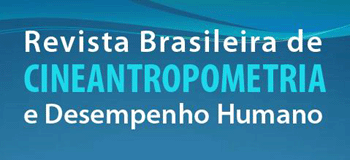Resumo
Este estudo teve como objetivo estimar a força propulsora da braçada(FPB) em jovens nadadores do estilo livre e propor uma equação para estimar a força propulsora, considerando variáveis antropométricas e a maturação. Setenta e seis nadadores competitivos [meninos: n = 53; idade = 13,58 ± 1,79; meninas: n = 23; idade = 12,98 ± 1,79] participaram deste estudo. Foram avaliados: altura, massa magra, estatura sentada, comprimento da perna, envergadura, dobra cutânea do tríceps, área muscular do braço (AMB) e maturação. A força propulsiva da braçada foi medida pelo teste de nado atado. Uma regressão linear múltipla (modelo concorrente) foi usada para desenvolver a equação usando as variáveis AMB, envergadura e maturação. O método de Bland – Altman foi utilizado para comparar os valores encontrados entre FPB e força propulsiva estimada (FPE). Houve correlação significativa entre as variáveis FPB e AMB (R² = 0,12; p <0,01), envergadura (R² = 0,21; p <0,01) e maturação (R² = 0,20; p <0,01) para meninos, enquanto os valores das meninas foram: AMB (R² = 0,07; p = 0,20), envergadura (R² = 0,50; p <0,01) e maturação (R² = 0,44; p <0,01). Duas equações lineares foram estabelecidas para predizer a FPB em meninos e meninas. A análise de Bland-Altman mostrou concordância entre FPB e FPE. Em conclusão, a equação é uma ferramenta valiosa para monitorar o treinamento e ajudar a melhorar o desempenho do nadador.
Palavras-chave
Antropometria; Força muscular; Natação

 Segmentos corporais e maturação biológica para estimar a força propulsiva da braçada em jovens nadadores
Segmentos corporais e maturação biológica para estimar a força propulsiva da braçada em jovens nadadores Thumbnail
Thumbnail
 Thumbnail
Thumbnail


